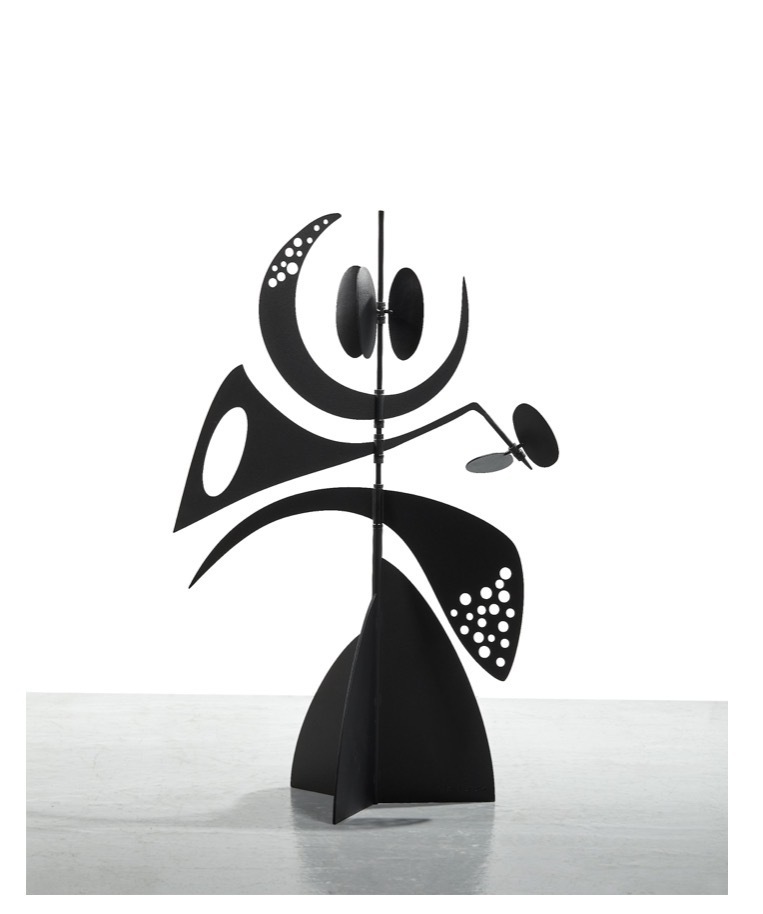Philippe HiquilyGirouette "Hiver"
2013-2020
Painted Steel
Stamped with the signature and numbered EA 2/4
39.76 x 24.02 x 27.56 in ( 101 x 61 x 70 cm )ZoomInquiry - Girouette "Hiver", 2013-2020
Certificat
Provenance
Private Collection, France
Artwork's description
“ Hiquily has always claimed his admiration for the work of Calder, whose work fascinates him and influences him considerably, particularly through his mobiles. The movement of elements under the action of natural phenomena such as wind or water is at the heart of his artistic concerns. But the sculptor very quickly finds his own style, his own “language” as he liked so much to say. Since his beginnings and throughout his career, the artist has designed moving works that come alive or sway by gesture, the action of water or a steel ball, and even of a random movement generated by a computer. It was in 1963 that he created his first monumental project in Marbella, Spain, with a theme that will be very dear to him throughout his work, the weather vane. A few weeks before his death at the beginning of 2013, Hiquily designed his last works: a set of four weather vanes and 1 stabile as part of a project of monumental works. Each of these weathervanes is named after one of the four seasons, and the stabile is titled L'Australienne “
Tara Hiquily
Artist's biography
Philippe Hiquily was born in Montmartre in 1925. He spent his adolescence at the Victor Duruy high school before joining the Resistance alongside his father at the age of 18. After the war, he briefly attended the Beaux-Arts in Orléans, then joined the Leclerc division for a two-year mission in Indochina (1945-1947). Upon his return, he enrolled at the École des Beaux-Arts in Paris, where he studied sculpture under the guidance of Janniot and Gimond. There, he met César, Albert Féraud, and Michel Guino, with whom he shared a passion for metal, a material that would become central to his work.
Philippe Hiquily developed his art in his father's workshop, an environment rich with Hellenistic studies, discovering Greece, Prehistory, and archaeology. The Musée de l'Homme became a major source of inspiration, particularly the Paleolithic Venus figurines. In 1954, he acquired a studio on Rue Raymond Losserand, where he could work freely. To support himself, he created and sold small objects at the Galerie du Siècle.
During this period, Hiquily frequented Germaine Richier's studio, where he made original bases for her sculptures. He met artists like Kijno, Claude Mary, and Robert Müller, and began developing his own style, influenced by Cycladic idols and salvaged materials. The retrospective of Julio Gonzalez in 1952 introduced him to direct metal cutting and autogenous welding, techniques he adopted.
His first mobiles, such as "Fontaine mobile" (1954) and "Automate" (1955), marked the introduction of movement in his sculptures. "L'Homme à la Bicyclette" (1955) was purchased by the National Museum of Modern Art, highlighting the significance of his work. Hiquily met Calder and was inspired by his mobile works, further developing lightness and balance in his creations.
The following decade saw the affirmation of the "Hiquilian style," which the critic Alain Jouffroy described as "erotic reality." Hiquily explored sexual and provocative themes, as evidenced by "La Motocyclette" (1964), later acquired by the Museum of Modern Art in Paris. The female figure, once maternal, became one of seduction and desire, embodying an unsettling and often castrating sensuality.
Hiquily's sculptures, such as "Le Copulateur" (1959) and the "Zoomorphes," achieved great success during exhibitions in New York. He collaborated with Jean-Jacques Lebel and Alain Jouffroy, creating anti-surrealist shows and exploring painting machines in response to action painting. His style evolved towards deliberate abstraction and simplification of forms, incorporating found objects into his sculptures.
In 1963, Hiquily created his first monumental work, a 12-meter weather vane in Marbella. He received several public commissions, integrating his sculptures into schools and other public buildings in France. He continued to develop monumental pieces while exploring new materials and techniques, such as polished brass.
By the late seventies, Hiquily reconnected with movement, inspired by Calder. He created mobile fountains and mechanical sculptures, participating in exhibitions on the themes of energy and movement. He also produced works for public commissions, integrating his sculptures into urban environments.
The eighties saw Hiquily diversify his work, incorporating everyday objects into his sculptures and exploring furniture design. His works, often provocative and imbued with humor, continued to surprise and fascinate. In 1995, a retrospective in Châteauroux brought him national recognition.
Philippe Hiquily continued to explore themes of couples and male-female relationships, sometimes softening the violence of his earlier works. He created sculptures inspired by dancers and showgirls, while continuing to integrate objects into his compositions. In 2010, he participated in the World Expo in Shanghai with a monumental sculpture.
Philippe Hiquily skillfully combined control and improvisation, rigor and humor, to create works that defy conventions and challenge our perception of reality. His sculptures, both provocative and aesthetically sublime, ensure him a place among the great creators of the second half of the 20th century.
